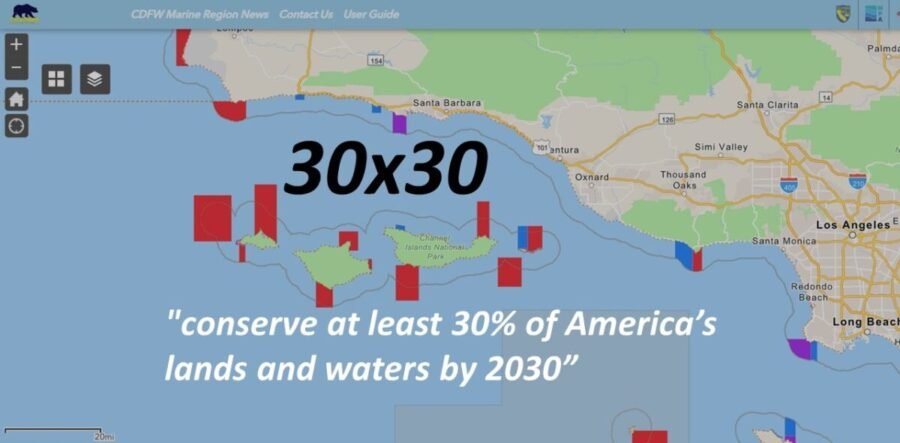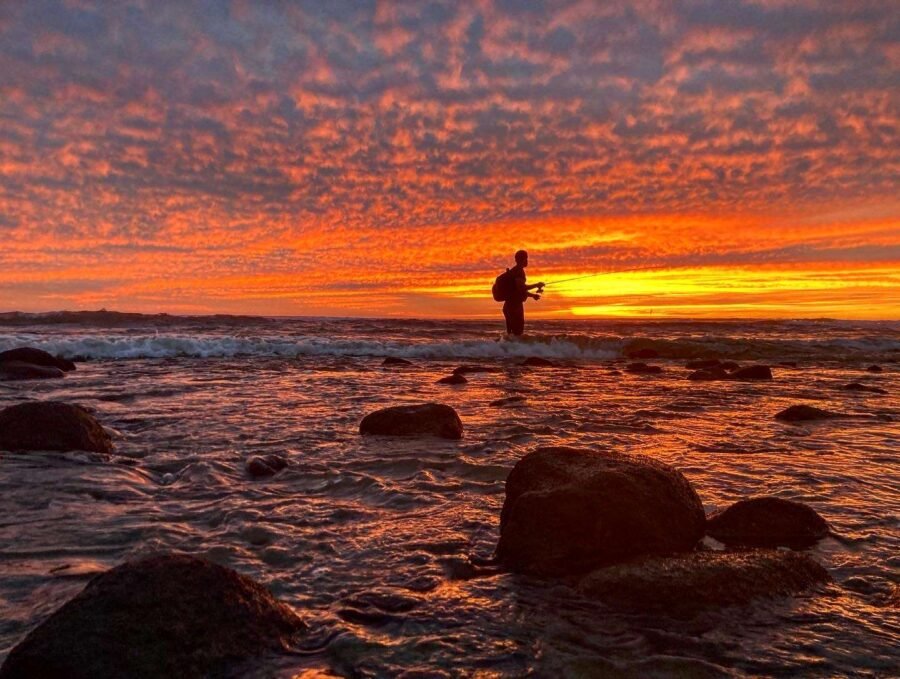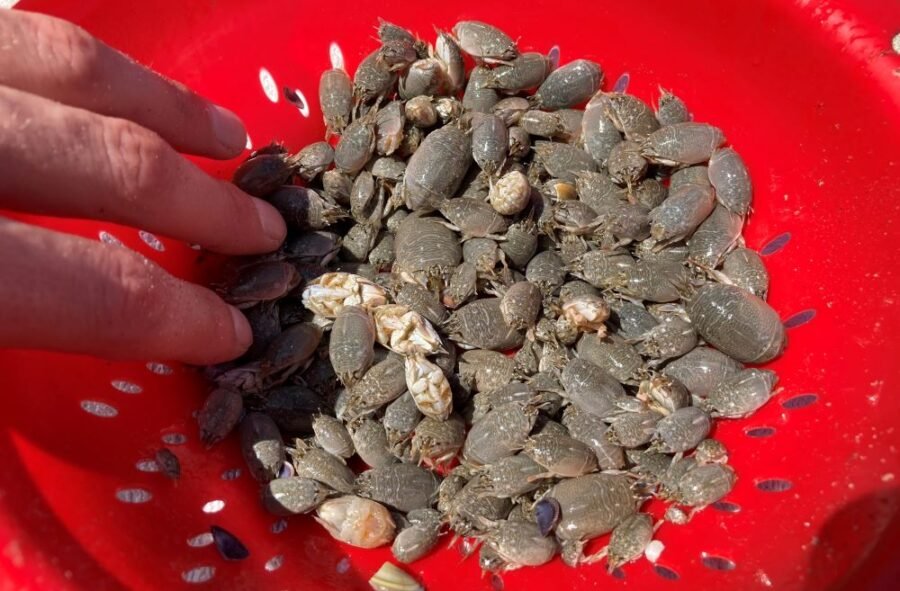California 30×30 Fishing Initiative: More No Fishing Zones to Come

What is 30 by 30? Timeline and Info
The term, “30×30” has been thrown around a lot as of late and if you don’t know what it’s referring to, it’s time you found out. 30 by 30 (or 30×30) is a worldwide initiative for governments to designate 30% of Earth’s land and ocean area as protected areas by 2030. It was initially proposed through an article in Science Advances in 2019, titled “A Global Deal for Nature: Guiding Principles, Milestones, and Targets”.
It was then initiated by the High Ambition Coalition for Nature and People in 2020. By 2021, more than 50 nations had agreed to the initiative, and by October of 2022, more than 100 countries had jumped along for the ride.
In October of 2020, California Governor Gavin Newsom issued Executive Order N-82-20 and in January of 2021, a similar executive order was issued by President Biden with it’s goal being inline with 30×30 “to conserve at least 30% of America’s lands and waters by 2030″.
My Humble Opinion
The past two years have been quite unorganized and ambiguous with respect to this initiative as early attempts were said to have left the angling and hunting community in the dark on much of the process. I’m not the first to make the case, but it doesn’t take a genius to realize it’s the hunting and fishing communities who hold the largest stake in conservation, and it’s that community… our community that funds conservation as we know it. Heck, it’s our community that’s funding 30×30.
Our oceans have been increasingly taken from us as fishermen and although conservation is extremely important, there are better ways to promote healthy ecosystems and thus fisheries than eliminating fishing. This is where limits and slot sizes are a perfect solution. I understand that 30×30 doesn’t explicitly state that plans include eliminating fishing in more areas, but I see the possibility as likely. I think there are better ways and I’d be the first to advocate for stricter limits and slots as I think many anglers (commercial and recreational) take more than they should even though it’s “legal”.
A Summary of the California 30×30 Initiative – In Reference to California Coastal Fishing
Originally, I had planned to write a detailed article explaining what the 30×30 initiative was in reference to hunting and fishing in California. I then planned to identify and broadcast a call to action that would allow anglers to voice their opinions and desires on this initiative. Sadly, I couldn’t seem to find any organized call to action or movement to stop the 30×30 or even to limit further use of “no fishing zones” to reach the 30% goal.
But, at the end of the day, since I couldn’t find a call to action, I will simply summarize the two major documents referencing California’s 30×30 initiative. In this article, I essentially identify what stood out to me from within these documents.
Keep in mind what’s in this article is a summary of the actual documents (linked above each section). These snippets are what I felt to be most relevant and the bolded text is what I found to stand out even further.
Pathways to 30×30 – What’s in the Document?
Pathways to 30×30 California – Document
- Tribe or tribal – used 6 times
- Reference to climate change – used 12 times
- In October 2020, Governor Gavin Newsom issued Executive Order N-82-20, which sets a goal of conserving 30% of the state’s lands and coastal waters by 2030.
- California’s coastal waters is defined as state waters extending from the mean high tide line to three nautical miles offshore, including estuaries, bays, and offshore islands.
- “Conservation” is defined as “Land and coastal water areas that are durably protected and managed to sustain functional ecosystems, both intact and restored, and the diversity of life that they support.”
- “Durably protected areas” is defined in Pathways to 30×30 as encompassing “areas under government ownership or control, primarily designated to protect species and their habitats; areas under perpetual easements that protect species and their habitats; or areas with species and habitat protection designations that have gone through a formal rulemaking or other enforceable decision-making process not subject to simple reversal.”
- Only California’s statewide network of 124 marine protected areas (MPAs) fully meets the definition of conservation.
- California’s MPA network covers 16% of state waters and includes both no-take state marine reserves and limited-take state marine conservation areas. Despite the fact that regulations vary from MPA to MPA, with only 9% of state waters fully protected by state marine reserves, California’s MPAs were designed and are adaptively managed as an ecologically cohesive network intended to help sustain healthy oceans on a statewide scale. Additionally, state marine conservation areas provide an excellent model for balancing biodiversity conservation with sustainable, well-managed commercial and recreational fishing. Therefore, the state currently considers 16% of coastal waters conserved.
- California Ocean Protection Council (OPC) stated that MPAs are not the only way to achieve conservation in coastal waters, and the state does not consider sustainable commercial or recreational fishing to necessarily be incompatible with conservation of the state’s coastal and marine biodiversity.
- California’s coastal waters also include complementary conservation measures, including marine managed areas that can be considered other effective area-based conservation measures (OECMs). Such areas, which include “de facto” MPAs (places where human activity is restricted by law for reasons other than conservation or natural resource management) as well as closures and restricted areas established for the purposes of fisheries management, have the potential to contribute to the state’s 30×30 goal, but their durability and biodiversity benefits require further study and potentially case-by-case assessment before determinations can be made about their conservation status.
Advancing 30×30 – What’s In the Document?
Advancing 30×30: Conservation of Coastal Waters – Document
- Tribe or tribal – used 61 times
- Climate change (or crisis) – used 11 times
- California is currently undertaking a review of the effectiveness of the statewide Marine Protected Area network and should build on the results of that review to inform future action. Based on the results, it may be important to secure additional protections for habitat types that are underrepresented in existing protected areas or to redesign existing protected areas that are not effective at meeting their objectives. For example, while some protected areas are focused on individual species of conservation interest, to effectively conserve, restore, and protect biodiversity, conservation efforts need to be broad and consider the ecosystem linkages and relationships that support those species
- If current protections are failing to protect biodiversity and key species, management policies and protections for these areas should be adjusted to ensure effective protections that advance the 30×30 goal. Examples include stronger enforcement of existing discharge regulations or prohibitions, modifications to fisheries management such as harvest quotas and gear type restrictions, and heightened requirements as needed to increase ecosystem resilience to climate change and other stressors.
- Restoring Indigenous stewardship to these areas is a critical step to support biodiversity, and begin to address the ecological and socio-cultural damage that has resulted from decades of genocide, forced relocations, systematic oppression, and management approaches that perceive humans as dominant over and separate from nature, that have been imposed under state and federal policies
- Stewardship may include actions that return coastal lands and waters to Tribal ownership, (re)application of traditional management practices, understanding and applying Indigenous Traditional Knowledge, developing Tribal marine management areas, and instituting co-management agreements with the state in coastal lands and waters. When conducted by California Tribes and Tribal Communities, these types of efforts should be considered actionable measures in defining marine conservation towards the 30×30 goal. The state should provide funding, support, and authorizations to foster the facilitation of such actions.
- In the development and implementation of 30×30 policies, there are several factors around Tribal governance, as well as knowledge sovereignty, that should be considered. For example, it is critical that the state consult directly with California Tribes and Tribal Communities in a meaningful manner that respects Tribal sovereignty and the unique government-to-government relationship. Secondly, free, prior, and informed consent from California’s Tribes and Tribal Communities should also be reached through direct representation at all levels of the state’s decision-making steps in this process. This should also include monitoring, assessment, and evaluation that will follow process implementation. The inherent responsibilities, aboriginal rights, and traditional/ ancestral ways of California Tribes and Tribal Communities must be fully considered in the use of existing and/or designation of new marine protected areas.
- Apply ecosystem-based fisheries management that considers biodiversity beyond commercially and recreationally important species. Monitoring and management in fisheries are often focused on commercially and recreationally important species; however, these species are part of a larger ecosystem that is reliant on each of its component parts. Each plant and animal species is a consumer or food source at some point in its life cycle…
- Adaptive fisheries management needs to focus on improving information flows, building capacity through partnerships, and policies that allow for responsive management to improve fishery outcomes and reduce threats from fishing and to fishing livelihoods.
- Expand on current monitoring efforts and increase the accessibility and timely application of collected data to support ocean management decisions and policy.
- Ecosystem-based monitoring will require collaboration among government, academic, and non-profit institutions to effectively assess the necessary breadth and interactions of habitats, species, and human influences.
- Along with flling the gaps in monitoring efforts off California’s coastline, it is essential that the data collected are made easily accessible to stakeholders and California Tribes and Tribal Communities, are translated into user-friendly data products that are regularly updated on state and local government websites, and intentionally and consistently applied to management decisions. The California Water Quality Monitoring Council34 can serve as a model for the coordination of monitoring, assessment, and reporting across agencies; however, additional funding in support of monitoring efforts would be benefcial to these programs. These efforts also need to extend beyond the state government. It is critical that the state engages the California Tribes and Tribal Communities that have historically managed and monitored these waters and can bring important and unique data and knowledge as well as assist in data collection throughout the state, including remote areas such as the North Coast.
- To reach California’s 30×30 goal and effectively conserve the state’s ocean and coastal habitats, conservation efforts must include effective and adaptive management to sustainably protect the biological structures and ecosystem functions that support habitat and species resilience. As ecosystems change and habitats shift, conservation and management policies must be dynamic and adaptable to remain effective. It is critical that these efforts are informed by Indigenous Traditional Knowledge, grounded in regularly updated scientifc monitoring, assessments, and data products, and guided by a precautionary approach to decision making that builds in protective buffers to projected climate change and other stressors. This process must be driven by engagement with stakeholders and California Tribes and Tribal Communities in order to successfully protect the unique environments found along our coast.


